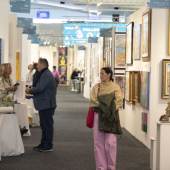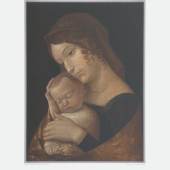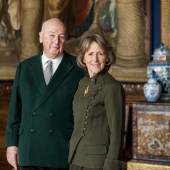Sotheby's Brings 'Treasures from Chatsworth' to New York This Summer
-
Ausstellung28.06.2019 - 18.09.2019
In 1856, William, 6th Duke of Devonshire, commissioned a seven-piece set of jewelry known as the Devonshire Parure, incorporating 88 carved gems from the large gem collection at Chatsworth that was assembled primarily by the 2nd and 4th Dukes of Devonshire.
The commission was a response to the Duke’s nephew’s attendance at the coronation of Tsar Alexander II of Russia, as a representative of Queen Victoria. Having previously attended the coronation of Tsar Nicholas I, the Duke could be certain that Maria, Countess Granville, would need a large and remarkable suite of jewels to furnish her wardrobe for the many functions she would attend and host.
Today the engraved gem collection at Chatsworth represents the largest such collection in private hands. Whilst prominent collections such as those of Thomas Howard, Earl of Arundel (1586-1646) and George Spencer, Fourth Duke of Marlborough (1739-1817) are now in the British Museum or dispersed through other collections both public and private, the Devonshire gems remain in the family which collected them.
LUCIAN FREUD
WOMAN IN A WHITE SHIRT
DEBORAH CAVENDISH, DUCHESS OF DEVONSHIRE
&
PORTRAIT OF A MAN
ANDREW CAVENDISH, 11th DUKE OF DEVONSHIRE
A highlight of the Treasures from Chatsworth exhibition will be two works reflecting the long association between the leading 20th century artist Lucian Freud and the 11th Duke and Duchess, whose portraits he was commissioned to paint. The strikingly-informal nature of the works speaks to the close association between sitter and artist: many of Freud’s works in the Devonshire Collection were completed while he stayed as their guest at Chatsworth.
These two informal portraits show Andrew Cavendish, 11th Duke of Devonshire (1920–2004), father of the current duke of Devonshire, and his Duchess, Deborah (née Mitford) (1920–2014). They form part of a group of oil paintings of the 11th Duke’s family that were painted over a period of approximately 20 years. As Freud used to explain: “I work from the people that interest me… I use them to invent my pictures with”.
Of the two portraits, Woman in White, the portrait of Duchess Deborah, was the first to be painted, in 1958-60. It marked a transitional point in Freud’s career, when he started to paint in a broader, looser style. He painted the portrait of the Duke a decade later, in 1971-72. It is also unconventional and disquieting. In it he appears to be unwilling to submit to the intense scrutiny of the artist, with his head is lowered and his eyes – ‘the mirror of the soul’ – hidden.
THE PEERESS ROBE
The Peeress robe was worn by Duchess Deborah when she attended the Coronation of Elizabeth II in 1953. The Duchess writes in her book, Wait for Me, about the worry of what she was going to wear to the coronation and about finding a crimson peeress's robe in tin trunks at Chatsworth, “with velvet of exceptional quality, so soft your fingers hardly know they are touching it”.
The one problem with the robe was that the bodice was cut off the shoulder, unlike the other peeress gowns. The 11th Duke and Duchess had to seek a dispensation from the Queen to allow Deborah to wear it. The bodice had been clearly altered and the neck line is typical of the 1830s, so it is thought that this dress was originally made for the 6th Duke’s sister, Lady Georgiana Cavendish, wife of the 6th Earl of Carlisle, to wear to the coronation of William IV in 1831.
RAFFAELE MONTI
THE VEILED VESTAL
On display in America for the first time ever will be one of Chatsworth’s visitors’ favorite objects: the Veiled Vestal by Victorian sculptor Raffaele Monti. Commissioned in Milan in 1846 by the 6th Duke of Devonshire – who was ahead of his time in recognizing the artist’s genius – this marble sculpture is now familiar to millions thanks to its star turn in the 2005 film adaptation of Pride and Prejudice.
A virtuoso piece of illusionistic carving, the statue is made up of four sections of Carrara marble. It shows a veiled Vestal Virgin guarding the sacred flame. In Ancient Rome, the six Vestals were virgin priestesses whose lives were dedicated to the goddess Vesta. They were responsible for ensuring that the sacred flame in Vesta’s temple in the Forum was never extinguished. The Vestals’ duty was regarded as fundamental to the safety of Rome.
Partly due to Duke’s patronage and partly for political reasons, Monti moved permanently to London in 1848. His output became prolific and his veiled figures became very popular in Britain. His career was assured with the display of his sculpted veiled figures at the capital’s Great Exhibition of 1851 – including the present work.
ANTHONY VAN DYCK
PORTRAIT OF JAN SNELLECK
Anthony van Dyck’s striking drawing of the Flemish artist, draughtsmen and collector Jan Snelleck is part of a group of celebrated portraits by Van Dyck of notable people of his age. This work is from a large collection of Old Master Drawings purchased via a private sale from Nicolas Anthonis Flinck in 1723/4 by the 2nd Duke of Devonshire.
Van Dyck, a leading pupil of Rubens, was an exceptional European artist particularly in the field of portraiture. As a portrait painter in England from 1632, he revolutionised the art of the portrait, influencing not only his contemporaries but also countless artists down the centuries.
LETTER SENT TO MARY CAVENDISH, DUCHESS OF DEVONSHIRE, BY JOHN F KENNEDY
21 SEPTEMBER 1944
-
12.04.2021 - 14.04.2021By Pak • 12- 14 April • A novel collection of digital art redefining our understanding...
-
20.04.2022ARTEXPO NEW YORK CELEBRATES ITS 45TH ANNUAL EDITION WITH A RENAISSANCE IN CONTEMPORARY AND FINE...
-
23.05.2018NEW YORK, 16 May 2018 – Today, Sotheby’s is honored to unveil the full contents of A...
-
Die politischen und geistigen Voraussetzungen machten Florenz zur Geburtsstadt der Renaissance....
-
11.12.2024Iconic Heuer Monaco Worn by Steve McQueen in LeMansRaces to Auction at Sotheby’s New York...
-
28.06.2019 - 18.09.2019
.

















